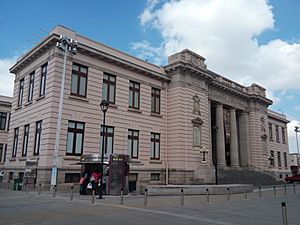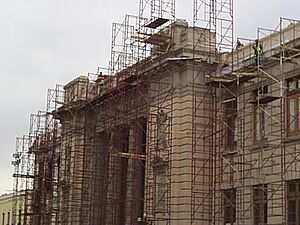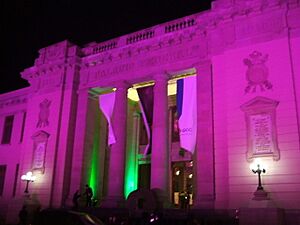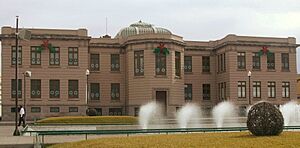Museo Casa Chihuahua facts for kids
The Casa Chihuahua Cultural Heritage Center is a special building in the city of Chihuahua, Mexico. It was built a long time ago, in the early 1900s. This building used to be called the Federal Palace of Chihuahua. It was where many government offices were located until 2004.
After 2004, the building was changed into a museum. Now, it shows different exhibits that travel from place to place. In the basement of Casa Chihuahua, you can find a very important jail cell. This cell belonged to Father Miguel Hidalgo y Costilla. He is known as the Father of the Nation because he was a main leader in Mexico's fight for independence from Spain. Father Hidalgo was captured in 1811. He was later executed on July 30, 1811, at a nearby building. His jail cell is now a national monument, a place people visit to remember him.
Contents
History of Casa Chihuahua
From College to Hospital
A long time ago, this spot was home to a college run by the Jesuit order. It was called "Colegio Jesuita de Nuestra Señora de Loreto." But in 1767, the Jesuits were told to leave all Spanish lands by King Charles III. So, the college building was left empty.
Later, the building became a 'Royal Military Hospital'. This is when Father Hidalgo was held there.
From Mint to Federal Palace
In 1878, the old college building was taken down. Only the tower where Father Hidalgo was held was saved. This was done because President Benito Juárez wanted it to be remembered. Today, this tower is part of the basement, but it used to be at ground level.
After the college was removed, a place called the Casa de Moneda was built. This was a special mint where Chihuahua made its own money for a while. Then, in 1908, the mint building was also taken down. A new building, the Federal Palace, was built in its place. It opened in 1910, just in time for Mexico's 100th birthday of independence.
A Place for Government and History
The Federal Palace was built to bring all the federal government offices together in one spot. During the Mexican Revolution, an important leader named Abraham Gonzalez was held prisoner here. He was the governor of Chihuahua and a mentor to Pancho Villa. Sadly, he was later killed.
The Palace also served as the main office for the Federal Postal Service in Chihuahua for many years.
Becoming a Cultural Center
In 2004, the postal service moved out of the building. The palace was then renovated to become a museum. It was named the Casa Chihuahua Cultural Heritage Center. The museum opened its doors in 2006. Today, it is one of the most famous places in the city. It serves as an important center for culture and history.
Architecture of the Building
The style of Casa Chihuahua was very popular when President Porfirio Diaz was in charge. It mixes two styles: neoclassicism and French Beaux Artes. The main entrance has two large columns. The walls have simple decorations, which is typical of the neoclassical style.
On the front of the building, you can see two important dates: 1811 and 1910. The year 1811 reminds us of when Miguel Hidalgo died. The year 1910 is when the building first opened. In the middle of the building, it says Palacio Federal, which means Federal Palace.
Exhibits and What You Can See
The Casa Chihuahua museum has three main areas for visitors to explore:
- Site Museum (Museo de Sitio): This area is in the basement and has three rooms. It tells the story of the building's history. You can learn about it from when it was a college, then a mint, and now a museum. Here, you can see Father Hidalgo's prison cell. It wasn't always a prison cell or underground. It was actually one of the towers of the old college church, at ground level. There's also a video that shows what Father Hidalgo's last months were like.
- Temporary Exhibit Area (Area de Exposiciones Temporales): This part of the museum is on the first floor and in the basement. It hosts new exhibits about every three months. Over the years, there have been more than 100 different exhibits. Some have shown beautiful glass art, the history of a mining town called Avalos, and the history of money in Mexico. There was even an exhibit about the life of Mother Teresa of Calcutta, showing some of her personal items.
- Chihuahua State Heritage Museum (Museo Patrimonial del Estado de Chihuahua): This museum is on the upper floor. It helps visitors learn about the amazing places and things to see in the State of Chihuahua. It uses pictures, videos, and sounds. This area is divided into three parts: the desert, the plains, and the mountains, showing the different landscapes of the state.
See also
 In Spanish: Museo Casa Chihuahua para niños
In Spanish: Museo Casa Chihuahua para niños





